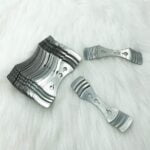Candle making is a craft that brings joy to many, but with it comes the inevitable cleanup of wax residue. Learning how to clean wax from candle making is essential for maintaining equipment and ensuring the quality of future candles. Proper wax cleanup not only prolongs the life of your candle making tools but also helps prevent potential safety hazards and ensures the purity of your wax for future projects.
One of the most common causes of frustration in candle making is dealing with wax spills and build-up on equipment. Whether you are a seasoned candle maker or just starting out, knowing the proper techniques for cleaning wax residue is crucial for maintaining a smooth and efficient candle making process.
To effectively clean your candle making equipment, there are specific tools and supplies that are necessary. From simple household items to specialized cleaning products, having the right materials on hand can make the task much easier. Additionally, understanding the proper storage and disposal of used candle making wax is essential for maintaining a clean and safe workspace.
In this article, we will explore step-by-step instructions for cleaning wax residue from candle making equipment, as well as tips for preventing future spills and build-up. We will also discuss troubleshooting common challenges in wax cleanup, so you can feel confident in maintaining your candle making equipment.
Common Causes of Wax Spills and Build-Up
Wax spills and build-up are common occurrences in the process of candle making. Understanding the causes of these issues can help prevent them and ensure a smoother candle making experience. Here are some common causes of wax spills and build-up:
1. Overfilling containers: Pouring too much wax into containers can lead to spills as the wax expands when it cools. It’s essential to leave some space at the top of the container to avoid overfilling.
2. Improper pouring technique: Pouring wax too quickly or from too high a distance can result in splashes and spills. It’s important to pour the wax carefully and steadily to avoid creating a mess.
3. Using cracked or damaged equipment: Cracks in melting pots or containers can cause leaks, leading to wax spills and build-up. It’s crucial to regularly inspect equipment for any damage and replace it as needed.
To clean wax from candle making equipment, you will need the following tools and supplies:
By understanding the common causes of wax spills and build-up, you can take steps to prevent these issues during your candle making process, resulting in a more efficient and enjoyable experience.
Tools and Supplies Needed for Proper Wax Cleanup
When it comes to cleaning wax from candle making, having the right tools and supplies is essential for a successful cleanup. Here are some of the items you will need to effectively remove wax residue from your candle making equipment:
- Hot soapy water: A mixture of hot water and dish soap is an effective and inexpensive way to clean wax from most candle making tools and surfaces.
- Scrapers and spatulas: Having a variety of scrapers and spatulas in different shapes and sizes will help you remove hardened wax from different surfaces, such as molds and containers.
- Rubbing alcohol: This can be used to dissolve wax residue on surfaces that cannot be submerged in hot water, such as wicks, thermometers, or scissors.
- Old towels or paper towels: These are useful for wiping away excess wax and cleaning up spills during the candle making process.
- Disposable gloves: Wearing gloves will protect your hands from the hot water, harsh chemicals, and sharp tools used during cleanup.
In addition to these basic supplies, having a dedicated space for cleaning up after candle making can also be helpful. A sink with a deep basin or a large plastic tub can be used specifically for washing candle making equipment. It’s important to avoid using the kitchen sink for this purpose since wax can clog drains over time.
Remember to properly ventilate the area when using rubbing alcohol or any other harsh chemicals to clean your equipment. Always wear protective gear like gloves and goggles as well. These simple precautions will not only protect your health but also ensure that your equipment is cleaned safely without causing any harm. With these tools and supplies on hand, you’ll be well-prepared to tackle any wax residue left behind by your candle making activities.
Step-by-Step Guide to Cleaning Wax Residue From Candle Making Equipment
Cleaning up wax residue from candle making equipment is an essential part of the candle making process. Not only does it ensure that your equipment remains in good condition, but it also prevents any cross-contamination of scents and colors in your future candles. Proper wax cleanup also helps to maintain the safety and efficiency of your equipment.
Gather Your Supplies
Before you begin cleaning up wax residue from your candle making equipment, you will need the right tools and supplies. This includes a heat-resistant scraper or spatula, paper towels or cloth rags, hot water, dish soap, rubbing alcohol, and a scrubbing brush. It’s important to gather these supplies before starting the cleanup process to ensure that you have everything you need within reach.
Scrape Off Excess Wax
Start the cleaning process by scraping off any excess wax from your equipment using a heat-resistant scraper or spatula. Be gentle yet thorough in this step to remove as much wax as possible before moving on to the next phase of cleaning.
Clean With Hot Water and Soap
After scraping off excess wax, wash the equipment with hot water and dish soap. Use a scrubbing brush to help remove any remaining wax residue or build-up. For stubborn areas, consider soaking the equipment in hot soapy water for an extended period before scrubbing again.
These steps demonstrate an effective way of how to clean wax from candle making while ensuring that your candle making equipment stays in the best condition for future use. Regular maintenance and proper care will extend the life of your tools and contribute to high-quality candles.
Tips for Preventing Wax Spills and Build-Up in the Future
Preventing wax spills and build-up in the future is essential for maintaining a clean and efficient candle making workspace. By taking proactive measures, you can save time and effort in the long run. Here are some tips to help prevent wax spills and build-up in your candle making process.
Use Proper Tools and Equipment
One of the main causes of wax spills and build-up is using inadequate or inappropriate tools and equipment. Investing in high-quality, heat-resistant containers, stirring utensils, and pouring pitchers can go a long way in preventing accidents and messes. Additionally, using a good quality thermometer can help you monitor the temperature of the wax, reducing the risk of overheating and spillage.
Work in a Controlled Environment
Creating your candles in a controlled environment can significantly reduce the likelihood of wax spills and build-up. Avoid working near open windows or fans that may cause drafts, as this can affect the temperature of your melting wax. Try to work on a stable surface to minimize the risk of accidental bumps or knocks that could lead to spills.
Clean as You Go
Regularly cleaning up any small wax drips or spills as you work can prevent them from accumulating over time. Keep a stack of paper towels or cleaning cloths handy to wipe down surfaces and tools during the candle making process. This simple habit can make a big difference in preventing stubborn wax build-up.
By following these preventive tips, you can minimize the occurrence of wax spills and build-up in your candle making workspace, ultimately saving time and effort in cleaning up afterwards.
How to Properly Store and Dispose of Used Candle Making Wax
Properly storing and disposing of used candle making wax is essential for maintaining a clean and organized workspace. Not only does it help prevent accidents and spills, but it also ensures that you can reuse leftover wax for future projects. Knowing how to properly store and dispose of used candle making wax will not only save you money in the long run but also contribute to a more sustainable candle making practice.
When it comes to storing used candle making wax, it’s important to keep it in a cool, dry place away from direct sunlight and heat sources. This will help prevent the wax from melting or becoming discolored over time.
It’s best to store the wax in airtight containers to protect it from dust, moisture, and pests. Be sure to label each container with the type of wax and color so that you can easily identify it when needed for future projects.
As for disposing of used candle making wax, there are several environmentally friendly options. One option is to recycle the wax by melting it down and using it for new candles or other crafts. Another option is to compost the wax if it is made from natural materials such as soy or beeswax. If neither of these options is feasible, you can contact your local waste management facility to inquire about proper disposal methods for candle making wax.
| Storage Tips | Disposal Options |
|---|---|
| Store in cool, dry place | Recycle by melting down |
| Keep away from sunlight and heat sources | Compost if natural materials like soy or beeswax |
| Use airtight containers | Contact local waste management facility for proper disposal methods |
Troubleshooting Common Wax Cleanup Challenges
Even with careful clean-up and maintenance, candle making equipment can sometimes present challenges when it comes to removing wax residue. One of the most common issues is hardened or stubborn wax that seems impossible to remove. When this happens, it’s important not to panic and resort to harsh chemicals that can damage your equipment.
One effective method for dealing with stubborn wax residue is to use heat. By gently warming the affected area with a hairdryer or heat gun, the wax will soften and become easier to remove. Be sure to use a low heat setting and avoid direct contact with plastic components, as excessive heat can cause damage.
Another common issue is the presence of small wax particles that seem to cling on no matter how much you scrub. In these cases, using oil can be very helpful. Apply a small amount of cooking oil or WD-40 onto a soft cloth and gently rub the affected area. This will help break down the wax and make it easier to wipe away. Remember to clean off any residual oil afterwards.
Lastly, for equipment with intricate designs or hard-to-reach areas, using a toothbrush can be very effective in removing stubborn wax build-up. The bristles can get into small crevices that other cleaning tools might miss, providing a thorough clean without causing damage.
| Troubleshooting Challenge | Recommended Solution |
|---|---|
| Hardened or stubborn wax | Use gentle heat from a hairdryer or heat gun |
| Small clinging wax particles | Apply oil (cooking oil or WD-40) onto a soft cloth and gently rub |
| Intricate designs or hard-to-reach areas | Use a toothbrush for detailed cleaning |
Final Thoughts
In conclusion, keeping your candle making equipment clean is essential for the quality and success of your candle-making endeavors. Proper wax cleanup not only ensures that your candles are free from any contaminants, but also extends the lifespan of your equipment. By following the step-by-step guide and using the right tools and supplies, you can easily maintain a clean workspace for your candle making.
Additionally, implementing preventive measures such as using a drip tray or aluminum foil can help minimize wax spills and build-up. Proper storage and disposal of used candle making wax is also crucial in maintaining a clean environment for future projects. By taking these extra precautions, you can save time and effort in cleaning up after each use.
Regular maintenance of your candle making equipment is key to achieving consistent results in your candle-making process. By addressing any troubleshooting challenges promptly and adhering to good practices for cleaning and storage, you can ensure that your equipment remains in top condition for years to come. Ultimately, maintaining a clean workspace not only improves the quality of your candles but also contributes to a safer and more enjoyable candle-making experience overall.
Frequently Asked Questions
How Do You Clean Candle Wax After Making Candles?
After making candles, cleaning candle wax can be done by scraping off any excess wax from the container using a butter knife or a spoon. Then, using a paper towel or cloth, blot the area to absorb as much wax as possible.
To remove any remaining residue, warm the container in hot water and wipe it clean with a cloth or sponge.
What Is the Best Thing to Clean Candle Wax With?
The best thing to clean candle wax with is hot water and dish soap. The hot water helps melt the wax for easier removal, while the dish soap helps break down any remaining residue. Additionally, using a butter knife or spoon to scrape off excess wax beforehand can also be helpful.
What Is the Easiest Way to Remove Wax From a Candle Jar?
The easiest way to remove wax from a candle jar is by placing the jar in the freezer for a few hours. Once the wax is frozen and brittle, it can be easily popped out of the jar with a butter knife or spoon.
Any leftover residue can be wiped clean with hot soapy water. This method is efficient and minimizes mess and effort in removing wax from candle jars.

Welcome to my candle making blog! In this blog, I will be sharing my tips and tricks for making candles. I will also be sharing some of my favorite recipes.





